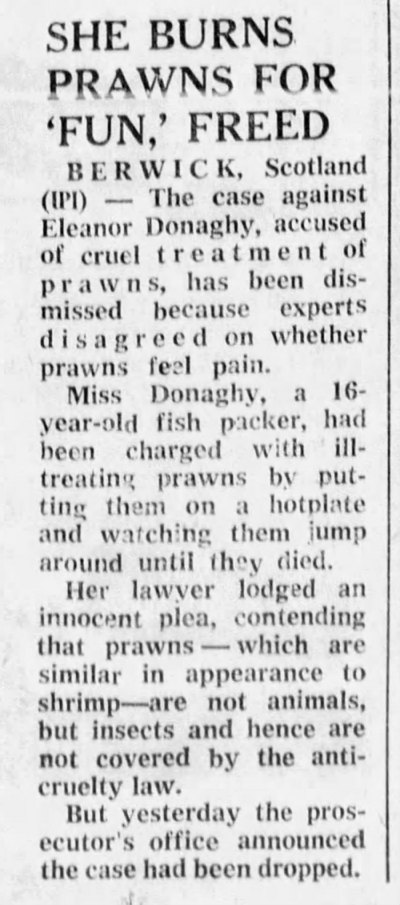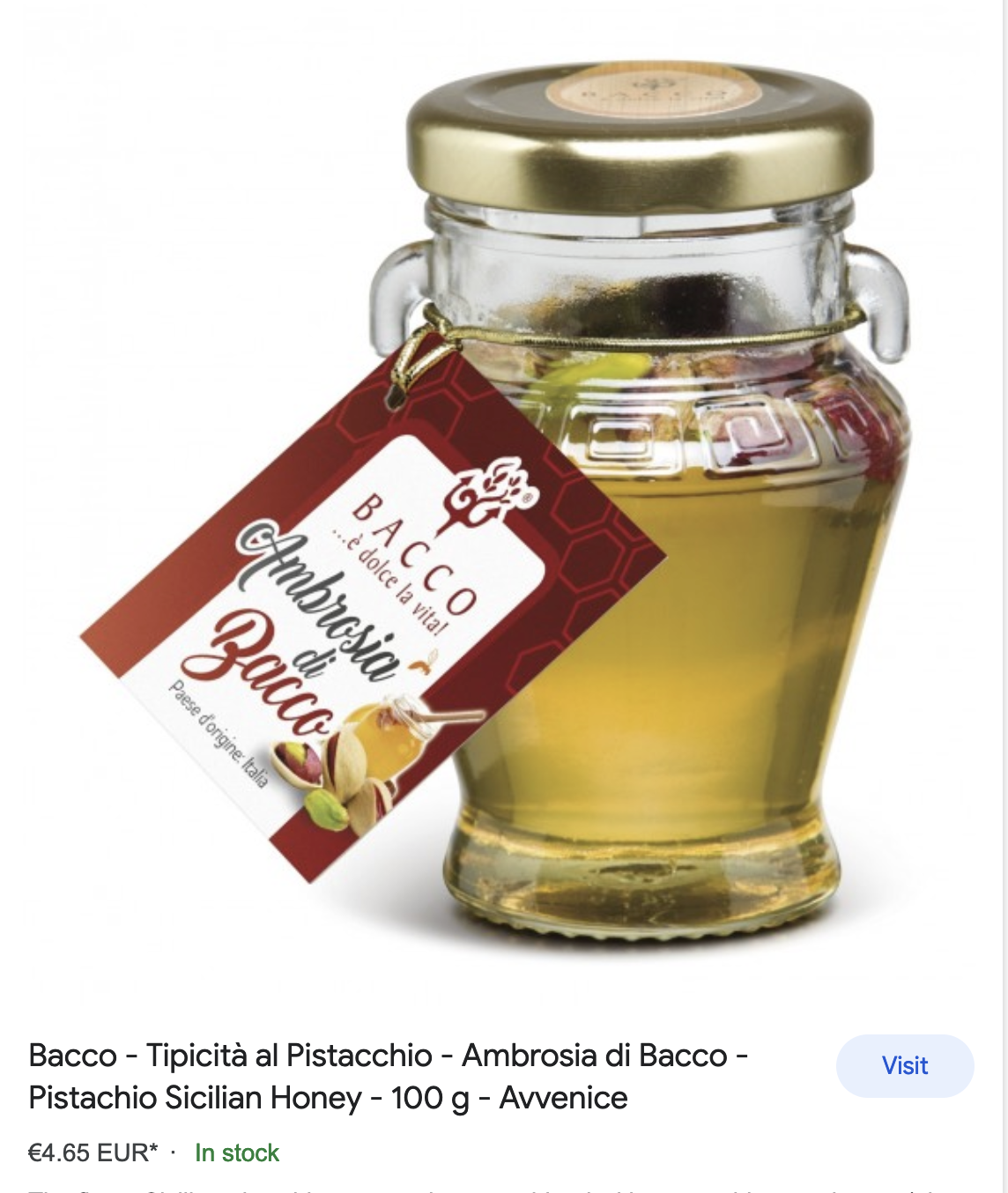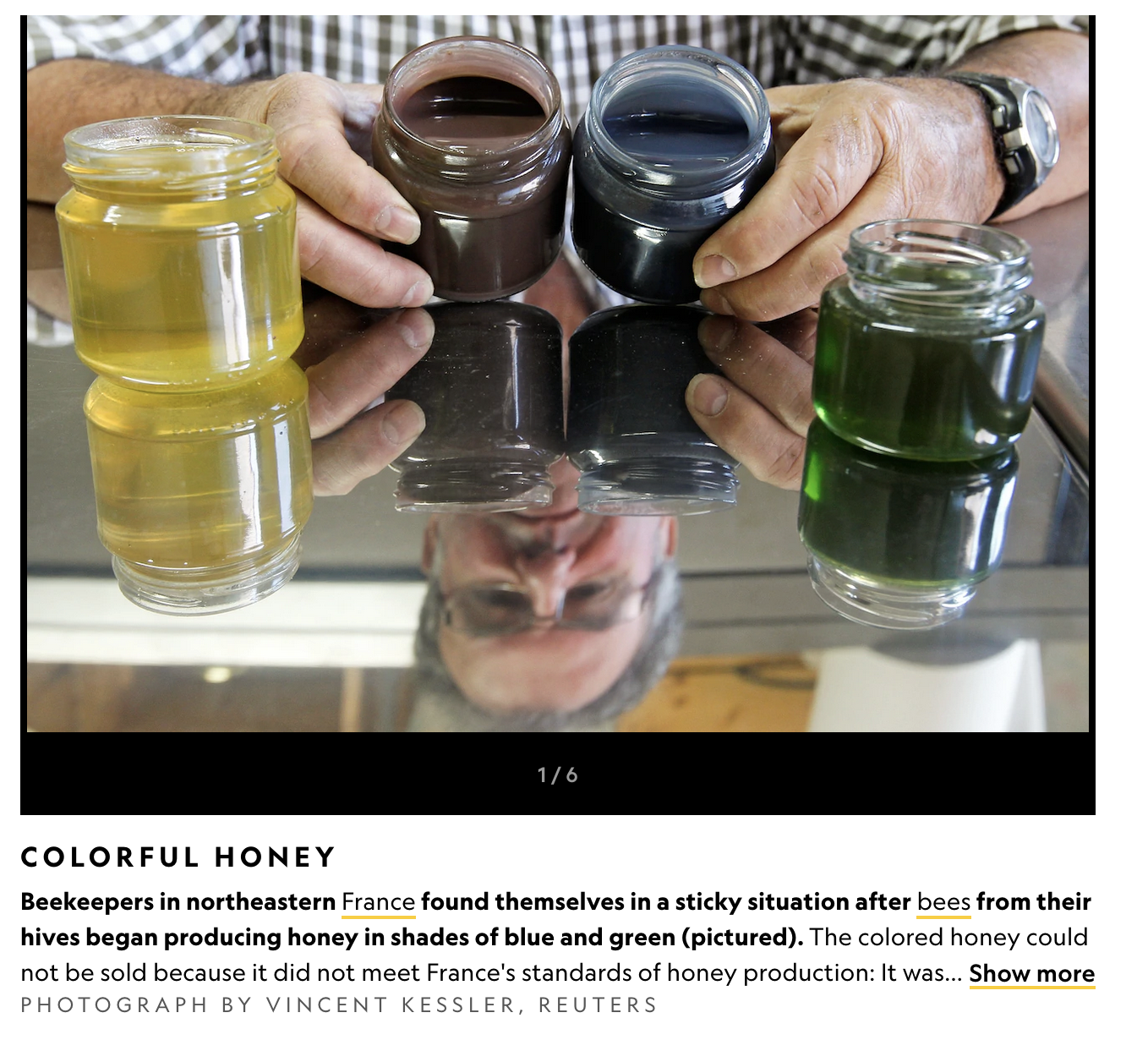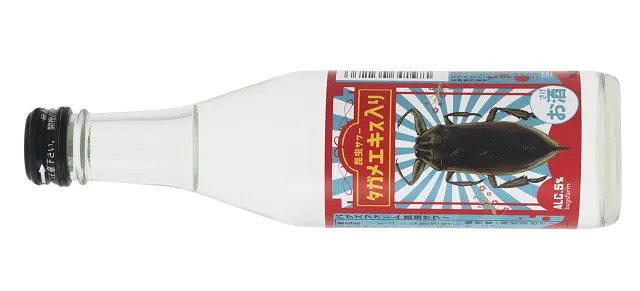Insects and Spiders
Ill-Treating Prawns
We've previously posted about a British case involving cruelty to goldfish. Here the British courts took up the question of whether it's possible to be cruel to prawns (aka shrimp), but dropped the case when it decided that prawns were insects and so not covered by anti-cruelty laws. They're actually crustaceans, but close enough I guess.
Feb 28, 1974 - Minneapolis Star
Posted By: Alex - Mon Sep 25, 2023 -
Comments (2)
Category: Insects and Spiders, Law, Sadism, Cruelty, Punishment, and Torture, United Kingdom
Hitler Species
There are two species of insects named after Hitler. The mystery, however, might be why more creatures weren't named after Hitler by German scientists during the 1930s, as a way to curry favor with him. The answer, surprisingly, seems to be that requests were made, but Hitler would always ask for his name not to be used. (The insect researchers never asked for his permission). Text from The Art of Naming by Michael Ohl (2018 translation):To date, Anophthalmus hitleri has been found in but a handful of caves in Slovenia. Particularly after the media discovered and circulated the Hitler beetle story in 2000, interest in this species has been rekindled. A well-preserved specimen of Anophthalmus hitleri can fetch upward of 2,000 euros on the collectors' market; among the bidders, certainly some wish to add the Hitler beetle to their collection of Nazi memorabilia. . .
At least one other species has been named after Adolf Hitler: the fossil Roechlingia hitleri, which belongs to the Palaeodictyoptera, a group of primitive fossil insects. Roechlingia hitleri was described in 1934 by German geologist and paleontologist Paul Guthörl. . .
Extensive research has failed to turn up any other species named in honor of Hitler. This seems surprising, as this form of salute could have proven quite expedient to aspiring German scientists from about 1933 until 1945, at the latest...
The likeliest explanation is that when Hitler patronyms were planned, approval was sought in advance from the Führer (by way of the Reich Chancellery), whether out of respect or perhaps fear of potential consequences. In 1933, for instance, a rose breeder submitted a written request to the Reich Chancellery for permission to introduce to the international market one of his best rose varieties, bearing Hitler's name. Similarly, a nursery owner from Schleswig-Holstein hoped to name a "prized strawberry variety" the "Hitler strawberry," in honor of the Reich Chancellor. They already had a "Hindenburg" strawberry variety in their catalog, he added. In reply to both cases, Hans Heinrich Lammers, Chief of the Reich Chancellery, sent almost identical letters, in which the inquiring parties were informed that, "upon careful consideration, [the reich Chancellor] requests that a name in his honor most kindly not be used." . . .
Perhaps this fundamental rejection of honorary names is the reason that so few hitleris exist.

Anophthalmus hitleri
source: Wikipedia
Posted By: Alex - Fri Sep 01, 2023 -
Comments (1)
Category: Dictators, Tyrants and Other Harsh Rulers, Insects and Spiders, Odd Names, Science
M&M Honey
I read this story upon its appearance, and for some reason it recently returned to the forefront of my mind. It seems that someone would have subsequently produced this intentionally.When I was in Sicily, I got to sample the light-green pistachio honey produced there.

NBC video report here.
Whole article and more pics here.

Posted By: Paul - Thu Jul 20, 2023 -
Comments (2)
Category: Food, Insects and Spiders, Europe, Twenty-first Century
Tortured by Ants
This isn't a type of crime one hears about very often:the boys were strapped to the tree for more than an hour, suffering the painful bites of thousands of ants.
On this subject, the Fossil Hunters site has an interesting article about forms of insect torture throughout history, including the gruesome ancient Persian practice of "scaphism," and the "Bug Pit" of Nasrullah Bahadur-Khan.

Alexandria Daily Town Talk - Aug 8, 1978
Posted By: Alex - Mon May 15, 2023 -
Comments (1)
Category: Insects and Spiders, Torture, Sadism, Cruelty, Punishment, and Torture, 1970s
Using gnats to predict the weather
Birds, insects, and reptiles provide a host of minor prophets, most of them with a gloomy message to proclaim. The noisy quacking of ducks and geese, the croaking of frogs, the loud singing of the missel-thrush, and the crawling of the toad across the road at dusk are one and all harbingers of rain.
The spider is the most interesting barometer. She prepares for wind by shortening the main filaments of her web. When these are unusually long, fine weather may be expected to last for 10 or 12 days. Very rarely is the web left alone for more than 24 hours. Complete cessation of work is said to be a sign of wet, but if activities are resumed during the rain it is an indication that the shower will not last long and will be followed by a spell of settled weather.

Nottingham Evening Post - July 23, 1956
click to enlarge
Posted By: Alex - Thu Feb 16, 2023 -
Comments (3)
Category: Insects and Spiders, Weather
Beatnik Fly
Their Wikipedia page.
Posted By: Paul - Thu Dec 01, 2022 -
Comments (2)
Category: Insects and Spiders, Music, Gonzo, Demento, Kooky, Wacky and Out-there, 1950s, 1960s
The Flea Circus
Posted By: Paul - Sun Mar 13, 2022 -
Comments (0)
Category: Insects and Spiders, 1940s, 1950s, Europe, United Kingdom, Circuses, Carnivals, and Other Traveling Shows
Insect Sour
A new alcoholic beverage, "Insect Sour," on sale in Japan boasts that its main ingredient is "giant water bug extract". These water bugs are apparently popular among bug aficionados because they have "a sweet, almost fruity, flavor comparable to some types of shellfish like shrimp."I bet it pairs well with Insect Balls.
More info: Sora News 24

Posted By: Alex - Wed Jan 05, 2022 -
Comments (1)
Category: Inebriation and Intoxicants, Insects and Spiders
Webs In The Wind
Webs in the Wind, published in 1949, is an odd, obscure book. The author, Winifred Duncan, decided that she wanted to learn more about spiders — creatures about which she previously had almost no knowledge.To do so, she caught spiders outside, released them in her house, and then patiently observed their behavior as they went about building webs in her curtains, between pieces of furniture, behind her toilet, etc. Her book is full of illustrations of the spider webs throughout her house.
Only after observing the spiders for months did she start reading any of the existing scientific literature about spiders.
Used copies of her book are quite expensive, starting at around $35. But you can read the entire book for free at the Hathitrust archive.




Posted By: Alex - Sun Nov 28, 2021 -
Comments (1)
Category: Insects and Spiders, Books, 1940s
What happens when a fly lands on your food
1970 ad for the UK Health Education Council. The text is credited to Charles Saatchi, who was then a young advertising executive (and is now a wealthy art collector).More info: The Guardian

Posted By: Alex - Tue Aug 31, 2021 -
Comments (1)
Category: Food, Insects and Spiders, Advertising, 1970s

| Who We Are |
|---|
| Alex Boese Alex is the creator and curator of the Museum of Hoaxes. He's also the author of various weird, non-fiction, science-themed books such as Elephants on Acid and Psychedelic Apes. Paul Di Filippo Paul has been paid to put weird ideas into fictional form for over thirty years, in his career as a noted science fiction writer. He has recently begun blogging on many curious topics with three fellow writers at The Inferior 4+1. Contact Us |




